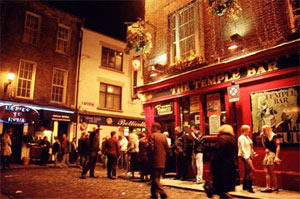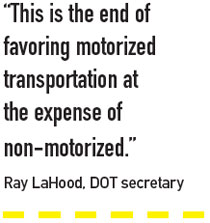Get This Show on the Road
the nation is starting to join the worldwide trend to increase investment in friendly streets

Back in March, Department of Transportation Secretary Ray LaHood proclaimed a major policy revision and beginning of a new era for our nation’s infrastructure.
“People across America who value bicycling should have a voice when it comes to transportation planning. This is the end of favoring motorized transportation at the expense of non-motorized,” he said. “We are integrating the needs of bicyclists in federally funded road projects. We are discouraging transportation investments that negatively affect cyclists and pedestrians. And we are encouraging investments that go beyond the minimum requirements and provide facilities for bicyclists and pedestrians of all ages and abilities.”

For a few decades, major cities around the globe have ramped up their investment in bike and pedestrian street features – most notably Amsterdam and Copenhagen – but it wasn’t until recent years that American cities like Portland, New York, Boulder, and Seattle have cracked the top lists. But now nearby cities of Madison and Minneapolis are becoming role models in their street design, too, and it’s becoming clear that increased investment is starting to hit closer to home.
The argument that these ideas are just another hippie or hipster fad has officially lost credibility. Over the past few years, focus on bicycle transportation has become increasingly popular according to Jay Ferm, advocacy coordinator for Planet Bike, a Madison-based bicycle component-maker and advocacy group. “Only 12 or 13 years ago there was only 10 or so major cycling advocacy groups… now there is at least 160.”
Nationwide in 2009, the federal government allocated a record high $1.2 billion to bicycle and pedestrian projects and programs. In the same year, cycling in Wisconsin contributed $1.5 billion to the state economy. From 1993 to 2008, Wisconsin DOT spent a total of $140 million on bike and pedestrian-specific projects, with each year showing an increase of investment (1993 has $6.8 million compared to 2008’s $19 million).
Though we’ve shown an increased investment over the years, we’re still a ways from progressive cities overseas. Denmark’s transportation budget, for instance, operates on a “two-thirds green, one-third black” traffic investment plan, meaning two-thirds of their funds go to public transit, biking, and pedestrians while car-based infrastructure gets a mere one-third. Can you imagine if that was the case on a federal, state, and local level?
For example, Eau Claire’s 2010 budget is about $3 million for street maintenance and $6.4 million for capital improvements, so following this Dutch example would mean $3.13 million would go for car-centric projects and $6.26 millions for bike, pedestrian, and public transit projects.
We’re nowhere near being able to emulate this model, and making these comparisons is like apples and oranges, according to City Manager Mike Huggins. Still, despite our reliance on car-based infrastructure, he added that he sees the city getting better and better. “There certainly isn’t anything two-thirds green, one-third black. But what has changed in the past 10 years is thinking of transportation from the multimodal perspective,” he said. “That’s definitely being incorporated and thought about. It’s a much greater priority than 10 years ago … and I’m speculating it will absolutely increase over time.”
Though a ways off, it’s a goal worth striving for and some are optimistic that we’ll one day get there.
“After WWII, cities were built for automobiles, not for bikes or pedestrians; it took us 50 years to get into this mess, hopefully it won’t take another 50 to get out,” says Ferm.
| "I've Never Seen That. I Hate It." « PREV | NEXT » Where the Money Comes From |


















